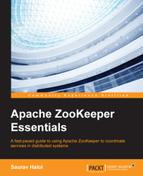Architecting and building a distributed system is not a trivial job, and implementing coordination systems for the distributed applications is even harder. They are often prone to errors such as race conditions and deadlocks, and such bugs are not easily detectable. Apache ZooKeeper has been developed with this objective in mind, to simplify the task of developing coordination and synchronization systems from scratch. ZooKeeper is an open source service, which enables high performance and provides highly available coordination services for distributed applications.
Apache ZooKeeper is a centralized service, which exposes a simple set of primitives that distributed applications can build on, in order to implement high-level services such as naming, configuration management, synchronization, group services, and so on. ZooKeeper has been designed to be easily programmable with its simple and elegant set of APIs and client bindings for a plethora of languages.
Apache ZooKeeper Essentials takes readers through an enriching practical journey of learning ZooKeeper and understanding its role in developing scalable and robust distributed applications. It starts with a crisp description of why building coordination services for distributed applications is hard, which lays the stepping stone for the need to know and learn ZooKeeper. This book then describes the installation and configuration of a ZooKeeper instance, after which readers will get a firsthand experience of using it.
This book covers the core concepts of ZooKeeper internals, its administration, and the best practices for its usage. The ZooKeeper APIs and the data model are presented in the most comprehensive manner for both beginners and experts, followed by programming with ZooKeeper. Examples of developing client applications have been given in three languages: Java, C, and Python. A full chapter has been dedicated to discuss the various ZooKeeper recipes so that readers get a vivid understanding of how ZooKeeper can be used to carry out common distributed system tasks.
This book also introduces readers to two projects: Curator and Exhibitor, which are used to ease the use of ZooKeeper in client applications and its management in production. Real-world examples of software projects that use ZooKeeper have been cited for readers to understand how ZooKeeper solves real problems. This is followed by examples of organizations that use ZooKeeper in their production platforms and enterprise software systems.
Apache ZooKeeper Essentials will help readers learn everything they need to get a firm grasp of ZooKeeper so that they can start building scalable and high-performant distributed applications with ease and full confidence.
Chapter 1, A Crash Course in Apache ZooKeeper, introduces you to distributed systems and explains why getting distributed coordination is a hard problem. It then introduces you to Apache ZooKeeper and explains how ZooKeeper solves coordination problems in distributed systems. After this, you will learn how to install and configure ZooKeeper, and get ready to start using it.
Chapter 2, Understanding the Inner Workings of Apache ZooKeeper, discusses the architecture of ZooKeeper and introduces you to its data model and the various operations supported by it. This chapter then delves deeper into the internals of ZooKeeper so that you understand how various components of ZooKeeper function in tandem.
Chapter 3, Programming with Apache ZooKeeper, introduces you to programming with the ZooKeeper client libraries and explains how to develop client applications for ZooKeeper in Java, C, and Python. This chapter presents ready-to-compile code for you to understand the nitty-gritty of ZooKeeper programming.
Chapter 4, Performing Common Distributed System Tasks, discusses the various recipes of distributed system tasks such as locks, queues, leader election, and so on. After going through these recipes, you will understand how ZooKeeper can be used to solve common coordination problems that are often encountered while building distributed systems.
Chapter 5, Administering Apache ZooKeeper, provides you with all the information that you need to know about the administration and configuration of ZooKeeper. It also presents the best practices of ZooKeeper usage and the various ways to monitor it.
Chapter 6, Decorating ZooKeeper with Apache Curator, cites details about two projects, Curator and Exhibitor, that make ZooKeeper programming and management easier and simpler.
Chapter 7, ZooKeeper in Action, discusses examples of real-world software systems, which use ZooKeeper at its core to carry out their functionalities. This chapter also presents examples of how various organizations are using ZooKeeper in their distributed platforms to solve coordination and synchronization problems and to build scalable and highly performant systems.
